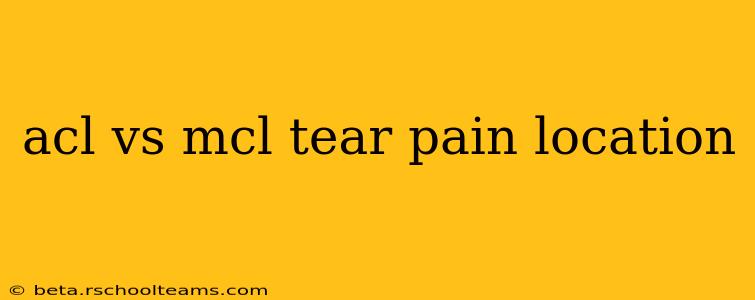Understanding the differences between an ACL (Anterior Cruciate Ligament) and MCL (Medial Collateral Ligament) tear can be crucial for proper diagnosis and treatment. Both are common knee injuries, particularly in athletes, but the location and nature of the pain differ significantly. This article will explore the pain associated with each injury, clarifying the distinctions and addressing common questions.
Where Does ACL Tear Pain Occur?
ACL tears typically cause pain in the center of the knee, often felt directly in the joint line. This pain is often described as a sharp, sudden pop at the moment of injury, followed by immediate swelling and instability. The pain might not be constant, but it’s likely to be noticeable when bearing weight or twisting the knee. Pain can radiate slightly to the front and sides of the knee but generally remains concentrated in the central area.
What Other Symptoms Accompany an ACL Tear?
Besides pain, ACL tears frequently present with other noticeable symptoms. These include:
- Swelling: Rapid swelling is a hallmark sign, often appearing within hours of the injury.
- Instability: The knee might feel “loose” or “gives way,” making it difficult to walk or put weight on the leg.
- Limited Range of Motion: Difficulty bending or straightening the knee is common.
- Popping or Clicking Sensation: Some individuals report feeling a popping or clicking sensation in the knee during movement.
Where Does MCL Tear Pain Occur?
MCL tears predominantly cause pain on the inside (medial) side of the knee. The pain is usually felt along the inner knee joint line, often radiating slightly down the inner thigh. Unlike ACL tears, the pain might not be accompanied by a sudden “pop.” Instead, it's often described as a dull ache or throbbing pain, particularly during knee movement.
What Other Symptoms Accompany an MCL Tear?
The symptoms accompanying an MCL tear can vary in severity depending on the grade of the tear (grade I, II, or III). Common symptoms beyond pain include:
- Swelling: Swelling may occur, but it’s usually less immediate and less severe than with an ACL tear.
- Stiffness: The knee may feel stiff and difficult to bend or straighten.
- Instability: While instability can occur, it’s often less severe than with an ACL tear, except in severe cases.
- Tenderness to the Touch: The medial side of the knee will likely be tender to the touch.
Is the pain always the same with an ACL or MCL tear?
No, the pain experience is subjective and can vary from person to person. While the typical locations described above are common, individual experiences can differ based on factors like the severity of the injury, the individual's pain tolerance, and other pre-existing conditions.
How can I tell the difference between an ACL and MCL tear without a doctor's examination?
It's impossible to accurately diagnose an ACL or MCL tear without a proper medical examination. The symptoms can overlap, and only a medical professional can perform the necessary tests (physical exam, MRI) to reach a definitive diagnosis. Self-diagnosis can lead to improper treatment and potentially worsen the injury.
What should I do if I suspect an ACL or MCL tear?
If you experience sudden knee pain, swelling, or instability following an injury, it's crucial to seek immediate medical attention. Rest, ice, compression, and elevation (RICE) can help manage the symptoms, but a proper diagnosis and treatment plan from a doctor are essential for recovery.
Disclaimer: This information is intended for educational purposes only and does not constitute medical advice. Always consult a healthcare professional for any health concerns or before making any decisions related to your health or treatment.
